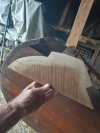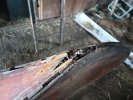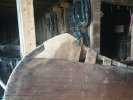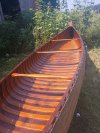Mud Bug
Hand made things are better
What do you fellas think of my approach to replacing the top of the stem? It's an old oak board I found in the barn and fitted to the curve of the stem and the angle of the deck. The tip of the deck was rotted away along with the stem, so I filed it back square between the inner gunwales to they can fasten to it too. (Four connections to the board: stem, deck, inner gunwales, planking.) I'll glue and screw it through both the stem and the deck, with the deck screws' heads underneath the copper band. Once it's in position I'll work the top down flush, of course. Seems like it'll be about as strong as the original. Oughta work doncha think?
This is a 1969 Otca my dad gave me a number of years ago which I'm finally am getting around to restoring. I'd never noticed that the center thwart is held on with wing nuts. I'm guessing that's so it can be taken in and out easily. Now why would anyone want to do that? A carrying yoke? I wouldn't think a single carrying yoke would be very useful with this 18 foot brute. And if you're paddling a canoe this big, wouldn't there be someone else to help carry it? The other two thwarts have regular 'ol brass square nuts.
This is a 1969 Otca my dad gave me a number of years ago which I'm finally am getting around to restoring. I'd never noticed that the center thwart is held on with wing nuts. I'm guessing that's so it can be taken in and out easily. Now why would anyone want to do that? A carrying yoke? I wouldn't think a single carrying yoke would be very useful with this 18 foot brute. And if you're paddling a canoe this big, wouldn't there be someone else to help carry it? The other two thwarts have regular 'ol brass square nuts.





